DUBAI: A new group show at the Hayy Jameel arts hub in Jeddah is bringing a bevy of artworks to the Kingdom, including a selection of works by artists who are being showcased in the country for the first time.
“The Distance from Here” runs from June 8 – Oct. 25, 2022 and explores spaces of transition, both physical and conceptual.
The exhibition includes major works drawn largely from the Art Jameel Collection, on view for the first time in Saudi Arabia. “The Distance from Here” is accompanied by a new publication; public and learning initiatives; newly commissioned performance and installation works; and a residency program. Featured artists range from up-and-coming creatives to established talents.

Yto Barrada, Lyautey Unit Blocks, 2010. (Supplied)
The artists include Mona Ayyash, Yto Barrada, Hicham Benohoud, Sarah Brahim, Jason Dodge, Shilpa Gupta, Joana Hadjithomas and Khalil Joreige, Anup Mathew Thomas, Filwa Nazer, Sreshta Rit Premnath, Hrair Sarkissian and Do Ho Suh.
Some of the works include Lebanese duo Joana Hadjithomas and Khalil Joreige’s “A Letter Can Always Reach Its Destination,” a video and hologram installation from 2012.
The work is part of their long-term “On Scams” project, for which they spent almost 20 years collecting spam and scam emails.
This particular work uses the text of selected spam and scams voiced by non-professional actors so that they “seem transformed into scenarios for monologues — stories that become captivating, even moving, because they are told by what seems to be a ‘real’ person,” the brochure says. “Nevertheless, the presence and complex layering of technological communication is echoed in the display, where one projection is ephemerally superimposed upon another, creating a ghostlike sensibility where the virtual and physical meet.”

Joana Hadjithomas and Khalil Joreige’s “A Letter Can Always Reach Its Destination,” a video and hologram installation from 2012. Supplied
Meanwhile, Hicham Benohoud’s “The Classroom” is a striking photography series shot over eight years around the turn of the millennium when he was working as an art teacher in Marrakech. “He actively involved his students in the making process, often providing physical constraints, prescribing specific poses and gestures or offering up different accessories to wear or use in order to construct within the space,” the brochure explains.
“Background” by Syrian artist Hrair Sarkissian was inspired by memories of his father’s studio in Damascus. The work highlights “the disappearance of a tradition of studio portraiture integral to the history and development of Middle Eastern photography in the twentieth century by documenting one of its central artefacts: the studio backdrop.” Sarkissian photographed hundreds of backdrops he discovered in Alexandria, Amman, Beirut, Byblos, Istanbul and Cairo, then selected one from each of the six cities to create images that “both monumentalize and eulogize their subject.” Seeing the backdrops empty like this, without a sitter in front of them, gives them an eerily desolate atmosphere, “like ruins or relics of a tradition that has finally run its course.”






















